Report on Investment Appraisal Techniques & Capital Structure
VerifiedAdded on 2023/06/11
|20
|3671
|158
Report
AI Summary
This report provides a detailed analysis of Faith Plc's capital structure and investment appraisal techniques. It covers the cost of equity, WACC calculation using both book and market values, and interprets the results. The report also examines the relationship between IRR and WACC. Furthermore, it evaluates investment appraisal techniques such as payback period, accounting rate of return (ARR), and net present value (NPV) for Pizza Mat (PM) Limited, including organizational effects and benefits/disadvantages in the sector. The analysis includes calculations and interpretations of financial data to assess the investment efficiency and financial significance of the companies.
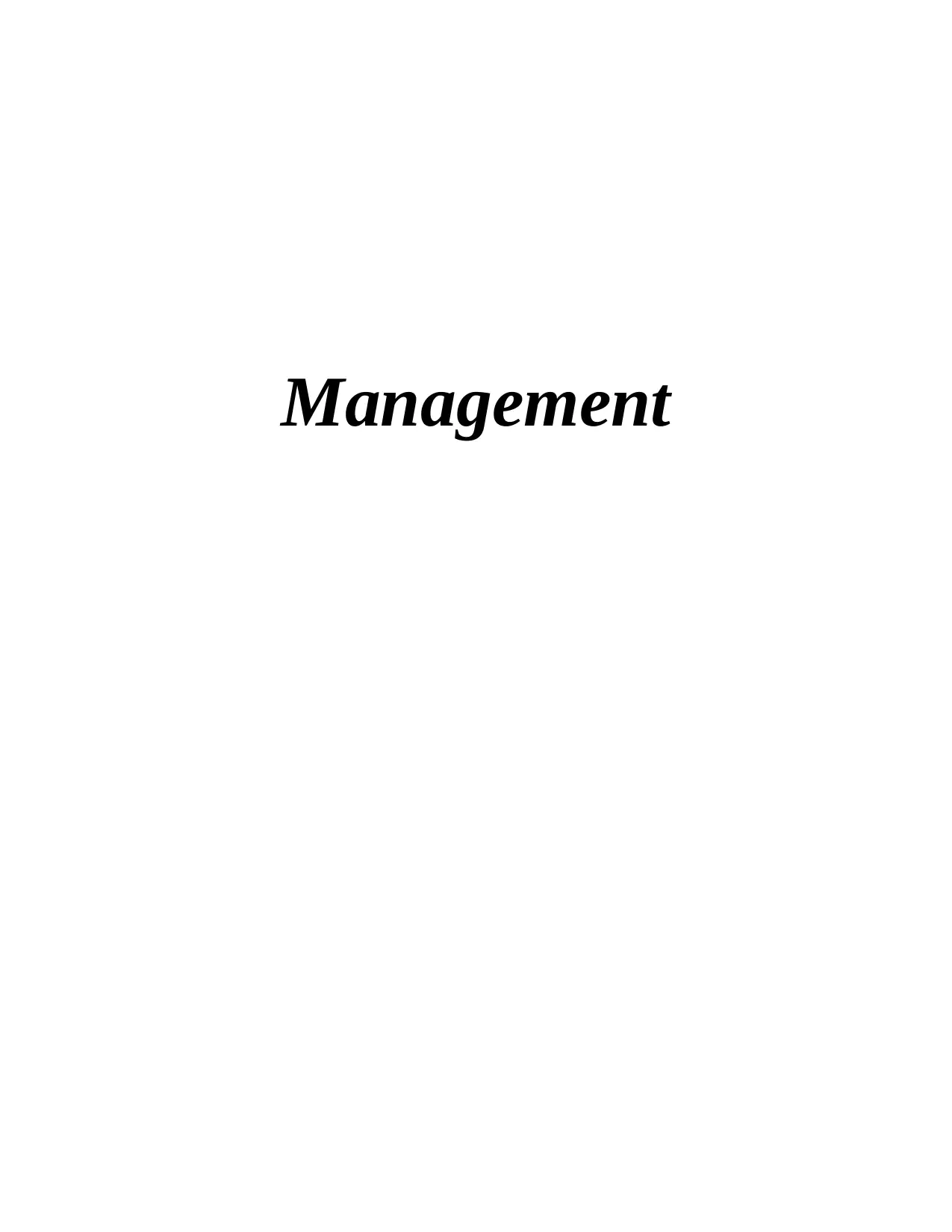
Management
Paraphrase This Document
Need a fresh take? Get an instant paraphrase of this document with our AI Paraphraser
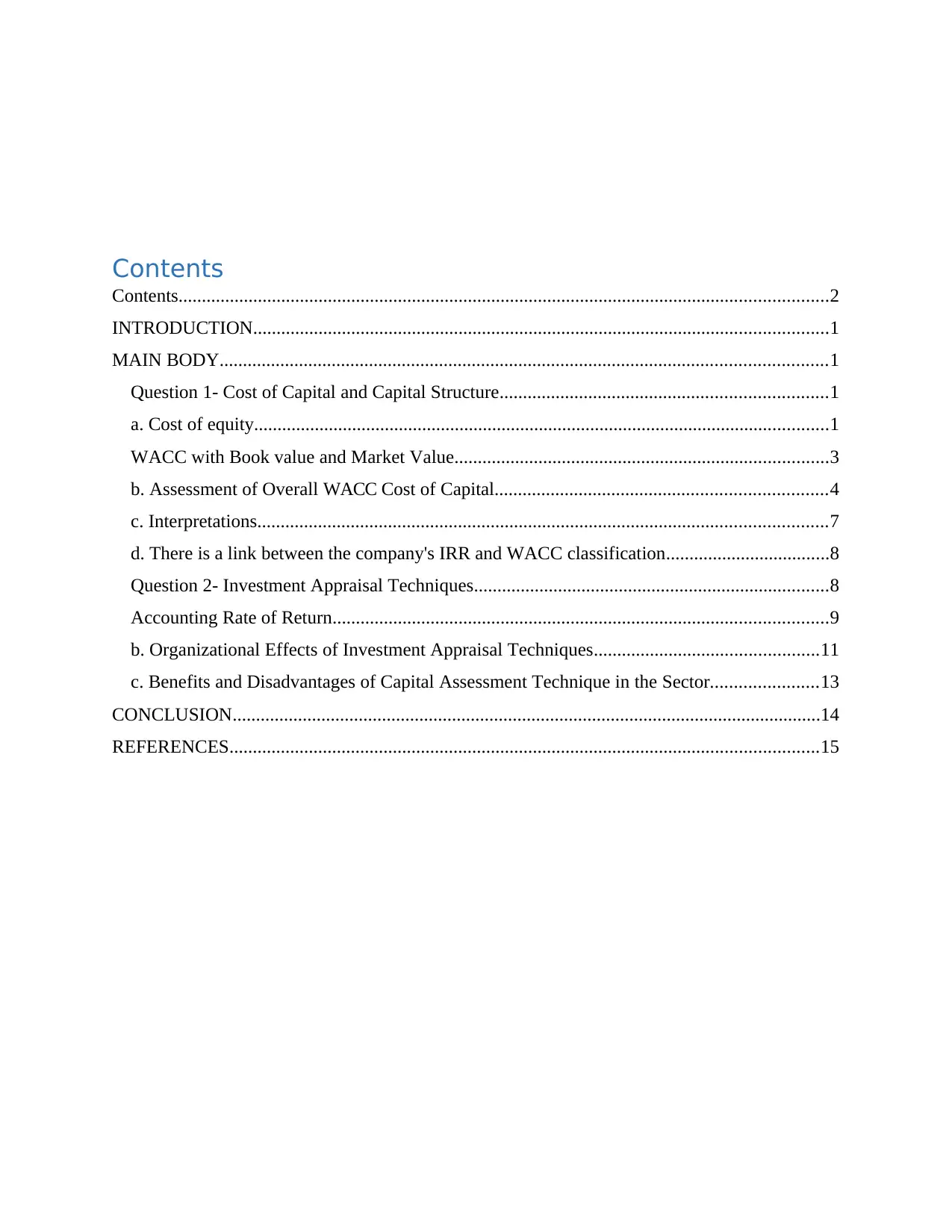
Contents
Contents...........................................................................................................................................2
INTRODUCTION...........................................................................................................................1
MAIN BODY..................................................................................................................................1
Question 1- Cost of Capital and Capital Structure......................................................................1
a. Cost of equity...........................................................................................................................1
WACC with Book value and Market Value................................................................................3
b. Assessment of Overall WACC Cost of Capital.......................................................................4
c. Interpretations..........................................................................................................................7
d. There is a link between the company's IRR and WACC classification...................................8
Question 2- Investment Appraisal Techniques............................................................................8
Accounting Rate of Return..........................................................................................................9
b. Organizational Effects of Investment Appraisal Techniques................................................11
c. Benefits and Disadvantages of Capital Assessment Technique in the Sector.......................13
CONCLUSION..............................................................................................................................14
REFERENCES..............................................................................................................................15
Contents...........................................................................................................................................2
INTRODUCTION...........................................................................................................................1
MAIN BODY..................................................................................................................................1
Question 1- Cost of Capital and Capital Structure......................................................................1
a. Cost of equity...........................................................................................................................1
WACC with Book value and Market Value................................................................................3
b. Assessment of Overall WACC Cost of Capital.......................................................................4
c. Interpretations..........................................................................................................................7
d. There is a link between the company's IRR and WACC classification...................................8
Question 2- Investment Appraisal Techniques............................................................................8
Accounting Rate of Return..........................................................................................................9
b. Organizational Effects of Investment Appraisal Techniques................................................11
c. Benefits and Disadvantages of Capital Assessment Technique in the Sector.......................13
CONCLUSION..............................................................................................................................14
REFERENCES..............................................................................................................................15

⊘ This is a preview!⊘
Do you want full access?
Subscribe today to unlock all pages.

Trusted by 1+ million students worldwide
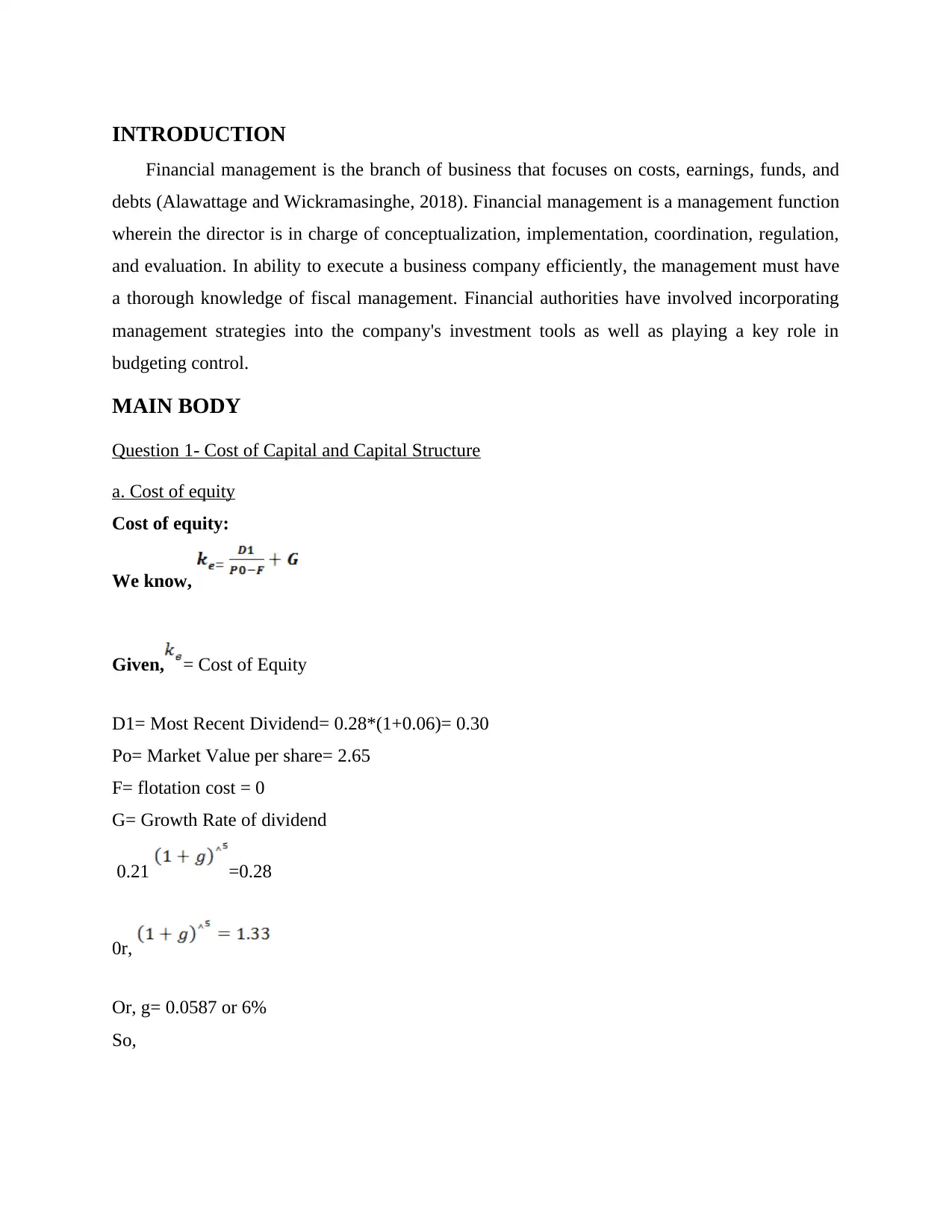
INTRODUCTION
Financial management is the branch of business that focuses on costs, earnings, funds, and
debts (Alawattage and Wickramasinghe, 2018). Financial management is a management function
wherein the director is in charge of conceptualization, implementation, coordination, regulation,
and evaluation. In ability to execute a business company efficiently, the management must have
a thorough knowledge of fiscal management. Financial authorities have involved incorporating
management strategies into the company's investment tools as well as playing a key role in
budgeting control.
MAIN BODY
Question 1- Cost of Capital and Capital Structure
a. Cost of equity
Cost of equity:
We know,
Given, = Cost of Equity
D1= Most Recent Dividend= 0.28*(1+0.06)= 0.30
Po= Market Value per share= 2.65
F= flotation cost = 0
G= Growth Rate of dividend
0.21 =0.28
0r,
Or, g= 0.0587 or 6%
So,
Financial management is the branch of business that focuses on costs, earnings, funds, and
debts (Alawattage and Wickramasinghe, 2018). Financial management is a management function
wherein the director is in charge of conceptualization, implementation, coordination, regulation,
and evaluation. In ability to execute a business company efficiently, the management must have
a thorough knowledge of fiscal management. Financial authorities have involved incorporating
management strategies into the company's investment tools as well as playing a key role in
budgeting control.
MAIN BODY
Question 1- Cost of Capital and Capital Structure
a. Cost of equity
Cost of equity:
We know,
Given, = Cost of Equity
D1= Most Recent Dividend= 0.28*(1+0.06)= 0.30
Po= Market Value per share= 2.65
F= flotation cost = 0
G= Growth Rate of dividend
0.21 =0.28
0r,
Or, g= 0.0587 or 6%
So,
Paraphrase This Document
Need a fresh take? Get an instant paraphrase of this document with our AI Paraphraser
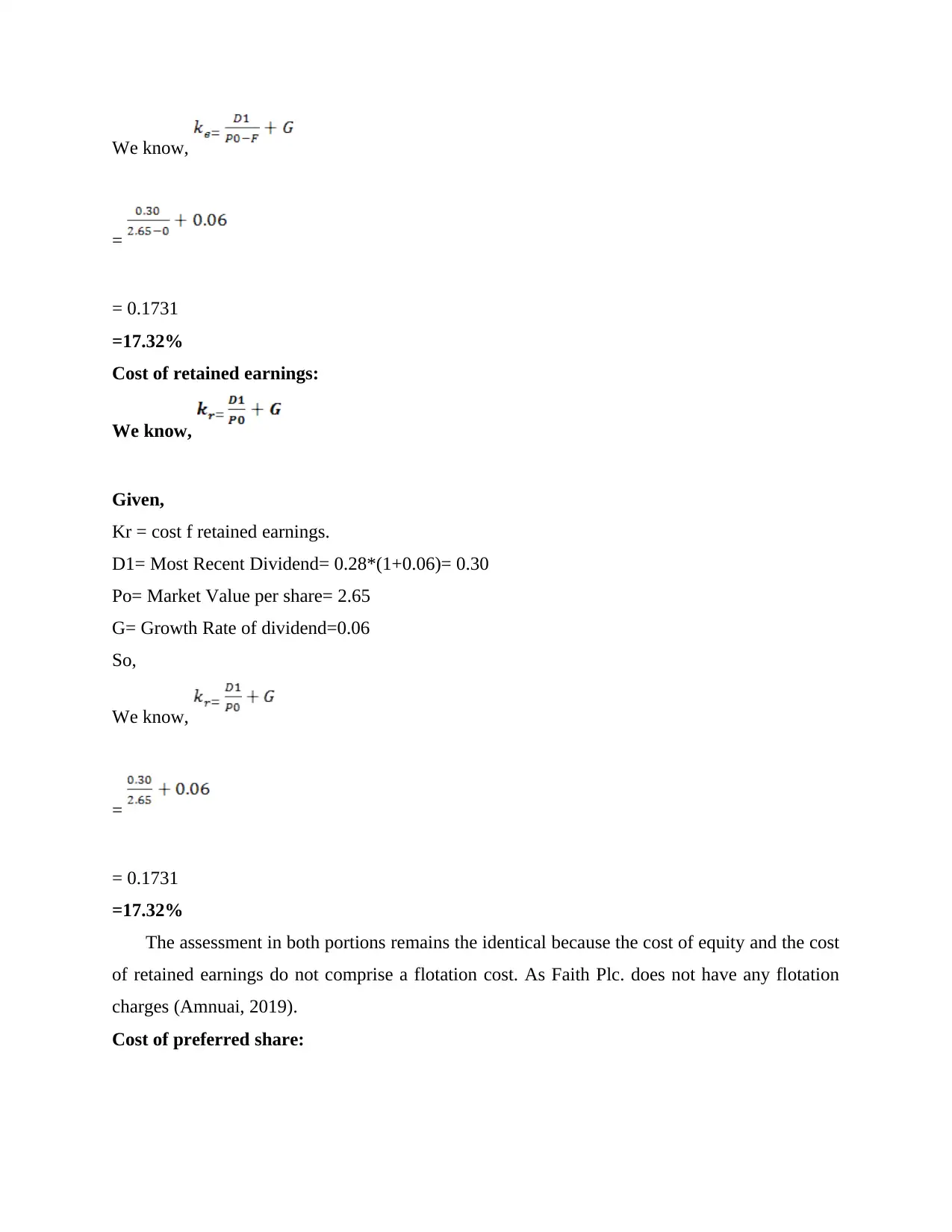
We know,
=
= 0.1731
=17.32%
Cost of retained earnings:
We know,
Given,
Kr = cost f retained earnings.
D1= Most Recent Dividend= 0.28*(1+0.06)= 0.30
Po= Market Value per share= 2.65
G= Growth Rate of dividend=0.06
So,
We know,
=
= 0.1731
=17.32%
The assessment in both portions remains the identical because the cost of equity and the cost
of retained earnings do not comprise a flotation cost. As Faith Plc. does not have any flotation
charges (Amnuai, 2019).
Cost of preferred share:
=
= 0.1731
=17.32%
Cost of retained earnings:
We know,
Given,
Kr = cost f retained earnings.
D1= Most Recent Dividend= 0.28*(1+0.06)= 0.30
Po= Market Value per share= 2.65
G= Growth Rate of dividend=0.06
So,
We know,
=
= 0.1731
=17.32%
The assessment in both portions remains the identical because the cost of equity and the cost
of retained earnings do not comprise a flotation cost. As Faith Plc. does not have any flotation
charges (Amnuai, 2019).
Cost of preferred share:
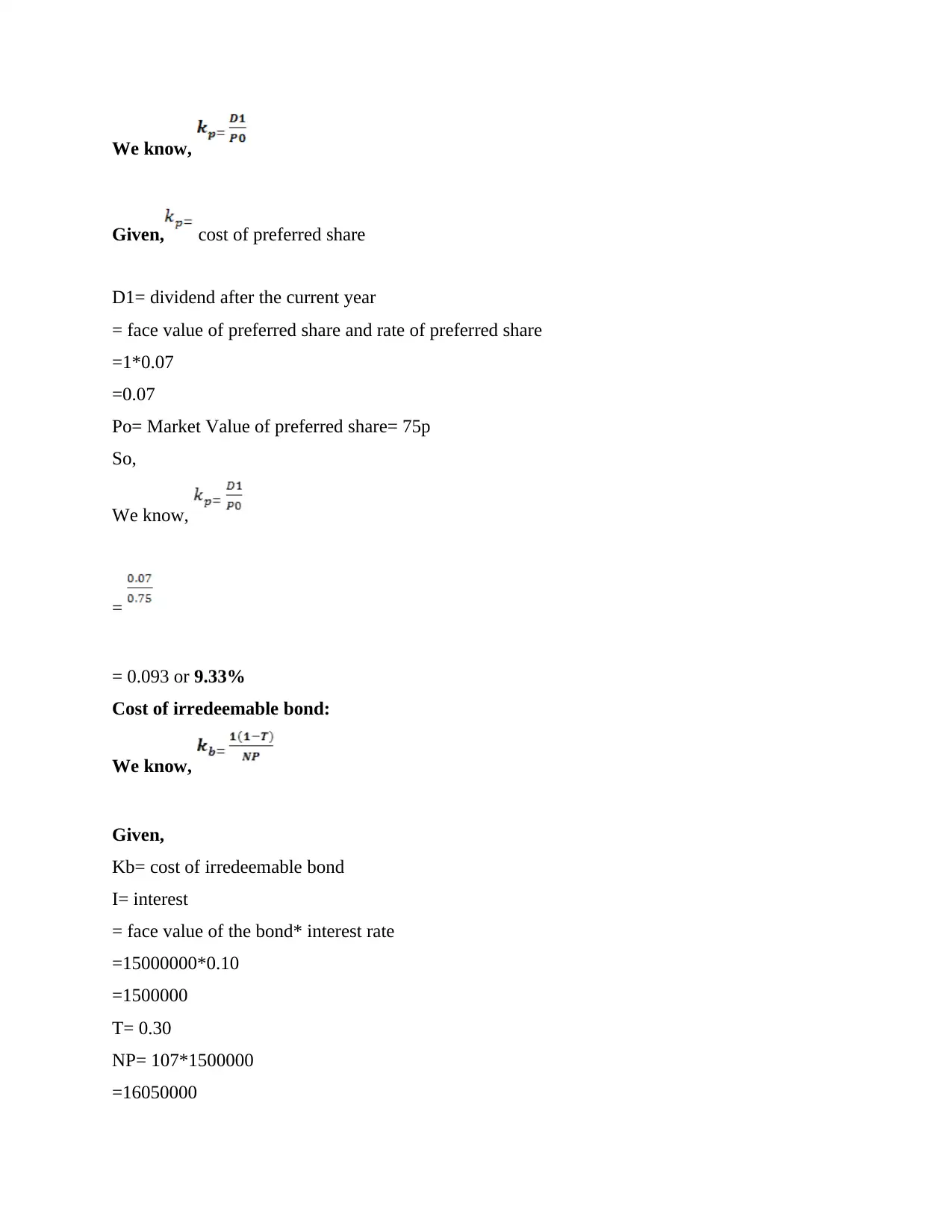
We know,
Given, cost of preferred share
D1= dividend after the current year
= face value of preferred share and rate of preferred share
=1*0.07
=0.07
Po= Market Value of preferred share= 75p
So,
We know,
=
= 0.093 or 9.33%
Cost of irredeemable bond:
We know,
Given,
Kb= cost of irredeemable bond
I= interest
= face value of the bond* interest rate
=15000000*0.10
=1500000
T= 0.30
NP= 107*1500000
=16050000
Given, cost of preferred share
D1= dividend after the current year
= face value of preferred share and rate of preferred share
=1*0.07
=0.07
Po= Market Value of preferred share= 75p
So,
We know,
=
= 0.093 or 9.33%
Cost of irredeemable bond:
We know,
Given,
Kb= cost of irredeemable bond
I= interest
= face value of the bond* interest rate
=15000000*0.10
=1500000
T= 0.30
NP= 107*1500000
=16050000
⊘ This is a preview!⊘
Do you want full access?
Subscribe today to unlock all pages.

Trusted by 1+ million students worldwide
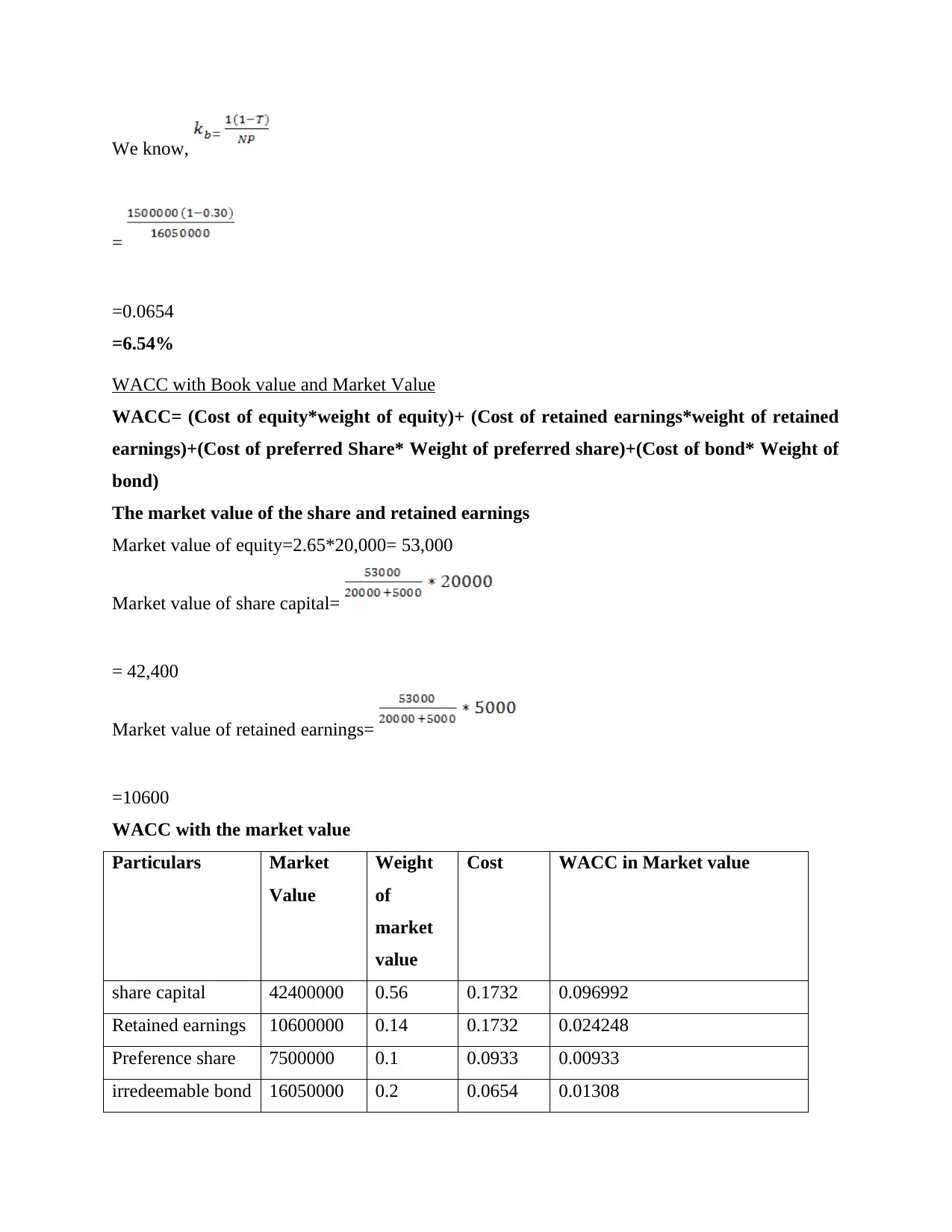
We know,
=
=0.0654
=6.54%
WACC with Book value and Market Value
WACC= (Cost of equity*weight of equity)+ (Cost of retained earnings*weight of retained
earnings)+(Cost of preferred Share* Weight of preferred share)+(Cost of bond* Weight of
bond)
The market value of the share and retained earnings
Market value of equity=2.65*20,000= 53,000
Market value of share capital=
= 42,400
Market value of retained earnings=
=10600
WACC with the market value
Particulars Market
Value
Weight
of
market
value
Cost WACC in Market value
share capital 42400000 0.56 0.1732 0.096992
Retained earnings 10600000 0.14 0.1732 0.024248
Preference share 7500000 0.1 0.0933 0.00933
irredeemable bond 16050000 0.2 0.0654 0.01308
=
=0.0654
=6.54%
WACC with Book value and Market Value
WACC= (Cost of equity*weight of equity)+ (Cost of retained earnings*weight of retained
earnings)+(Cost of preferred Share* Weight of preferred share)+(Cost of bond* Weight of
bond)
The market value of the share and retained earnings
Market value of equity=2.65*20,000= 53,000
Market value of share capital=
= 42,400
Market value of retained earnings=
=10600
WACC with the market value
Particulars Market
Value
Weight
of
market
value
Cost WACC in Market value
share capital 42400000 0.56 0.1732 0.096992
Retained earnings 10600000 0.14 0.1732 0.024248
Preference share 7500000 0.1 0.0933 0.00933
irredeemable bond 16050000 0.2 0.0654 0.01308
Paraphrase This Document
Need a fresh take? Get an instant paraphrase of this document with our AI Paraphraser
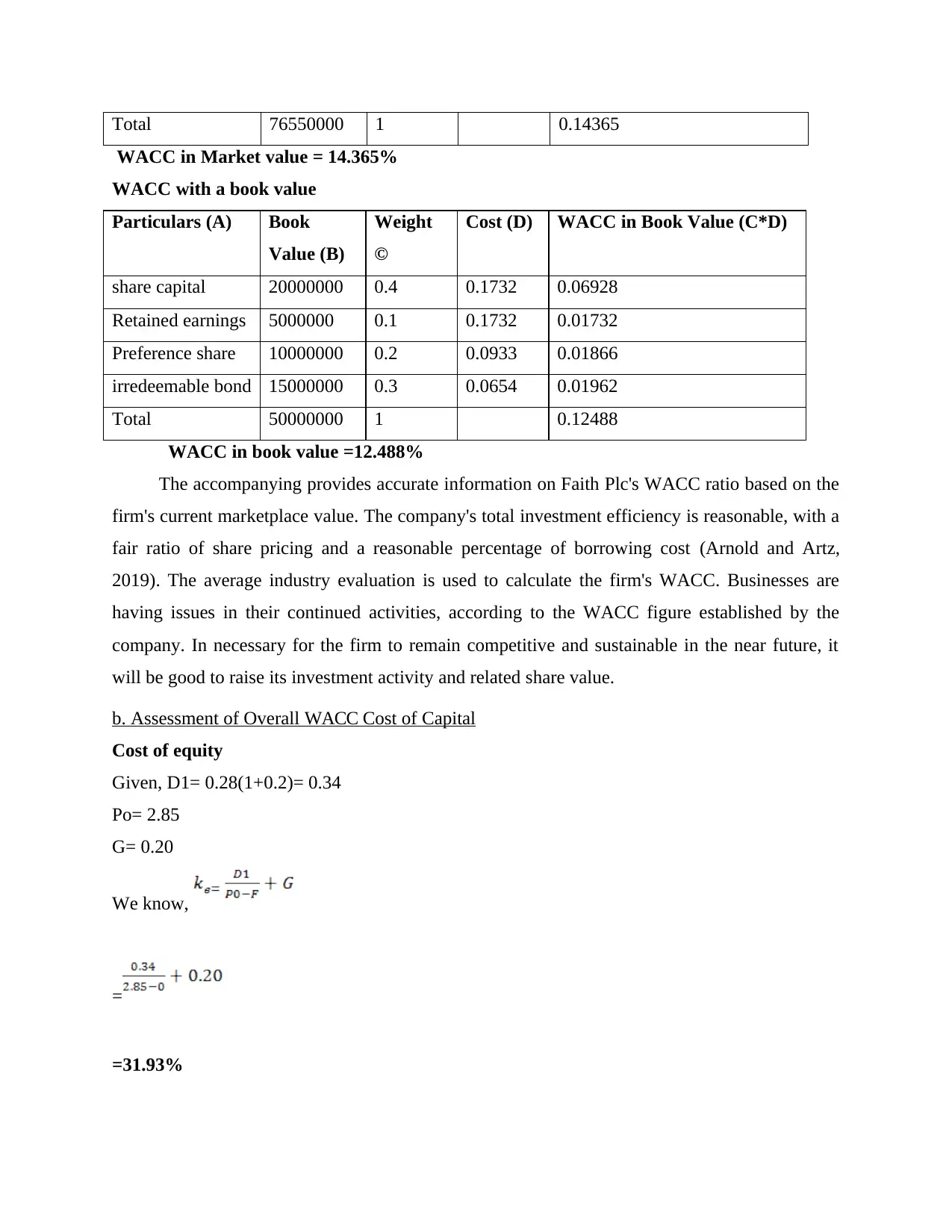
Total 76550000 1 0.14365
WACC in Market value = 14.365%
WACC with a book value
Particulars (A) Book
Value (B)
Weight
©
Cost (D) WACC in Book Value (C*D)
share capital 20000000 0.4 0.1732 0.06928
Retained earnings 5000000 0.1 0.1732 0.01732
Preference share 10000000 0.2 0.0933 0.01866
irredeemable bond 15000000 0.3 0.0654 0.01962
Total 50000000 1 0.12488
WACC in book value =12.488%
The accompanying provides accurate information on Faith Plc's WACC ratio based on the
firm's current marketplace value. The company's total investment efficiency is reasonable, with a
fair ratio of share pricing and a reasonable percentage of borrowing cost (Arnold and Artz,
2019). The average industry evaluation is used to calculate the firm's WACC. Businesses are
having issues in their continued activities, according to the WACC figure established by the
company. In necessary for the firm to remain competitive and sustainable in the near future, it
will be good to raise its investment activity and related share value.
b. Assessment of Overall WACC Cost of Capital
Cost of equity
Given, D1= 0.28(1+0.2)= 0.34
Po= 2.85
G= 0.20
We know,
=
=31.93%
WACC in Market value = 14.365%
WACC with a book value
Particulars (A) Book
Value (B)
Weight
©
Cost (D) WACC in Book Value (C*D)
share capital 20000000 0.4 0.1732 0.06928
Retained earnings 5000000 0.1 0.1732 0.01732
Preference share 10000000 0.2 0.0933 0.01866
irredeemable bond 15000000 0.3 0.0654 0.01962
Total 50000000 1 0.12488
WACC in book value =12.488%
The accompanying provides accurate information on Faith Plc's WACC ratio based on the
firm's current marketplace value. The company's total investment efficiency is reasonable, with a
fair ratio of share pricing and a reasonable percentage of borrowing cost (Arnold and Artz,
2019). The average industry evaluation is used to calculate the firm's WACC. Businesses are
having issues in their continued activities, according to the WACC figure established by the
company. In necessary for the firm to remain competitive and sustainable in the near future, it
will be good to raise its investment activity and related share value.
b. Assessment of Overall WACC Cost of Capital
Cost of equity
Given, D1= 0.28(1+0.2)= 0.34
Po= 2.85
G= 0.20
We know,
=
=31.93%
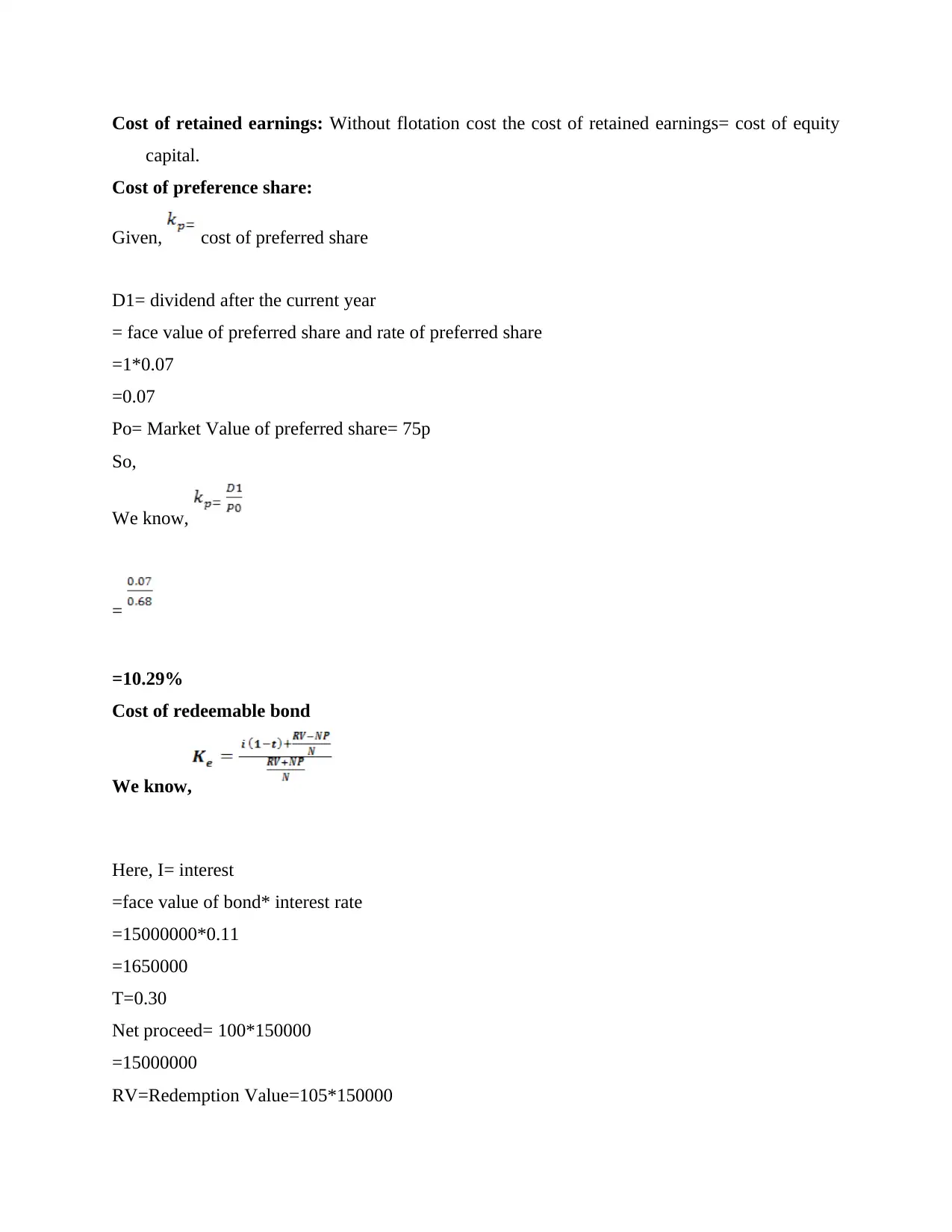
Cost of retained earnings: Without flotation cost the cost of retained earnings= cost of equity
capital.
Cost of preference share:
Given, cost of preferred share
D1= dividend after the current year
= face value of preferred share and rate of preferred share
=1*0.07
=0.07
Po= Market Value of preferred share= 75p
So,
We know,
=
=10.29%
Cost of redeemable bond
We know,
Here, I= interest
=face value of bond* interest rate
=15000000*0.11
=1650000
T=0.30
Net proceed= 100*150000
=15000000
RV=Redemption Value=105*150000
capital.
Cost of preference share:
Given, cost of preferred share
D1= dividend after the current year
= face value of preferred share and rate of preferred share
=1*0.07
=0.07
Po= Market Value of preferred share= 75p
So,
We know,
=
=10.29%
Cost of redeemable bond
We know,
Here, I= interest
=face value of bond* interest rate
=15000000*0.11
=1650000
T=0.30
Net proceed= 100*150000
=15000000
RV=Redemption Value=105*150000
⊘ This is a preview!⊘
Do you want full access?
Subscribe today to unlock all pages.

Trusted by 1+ million students worldwide
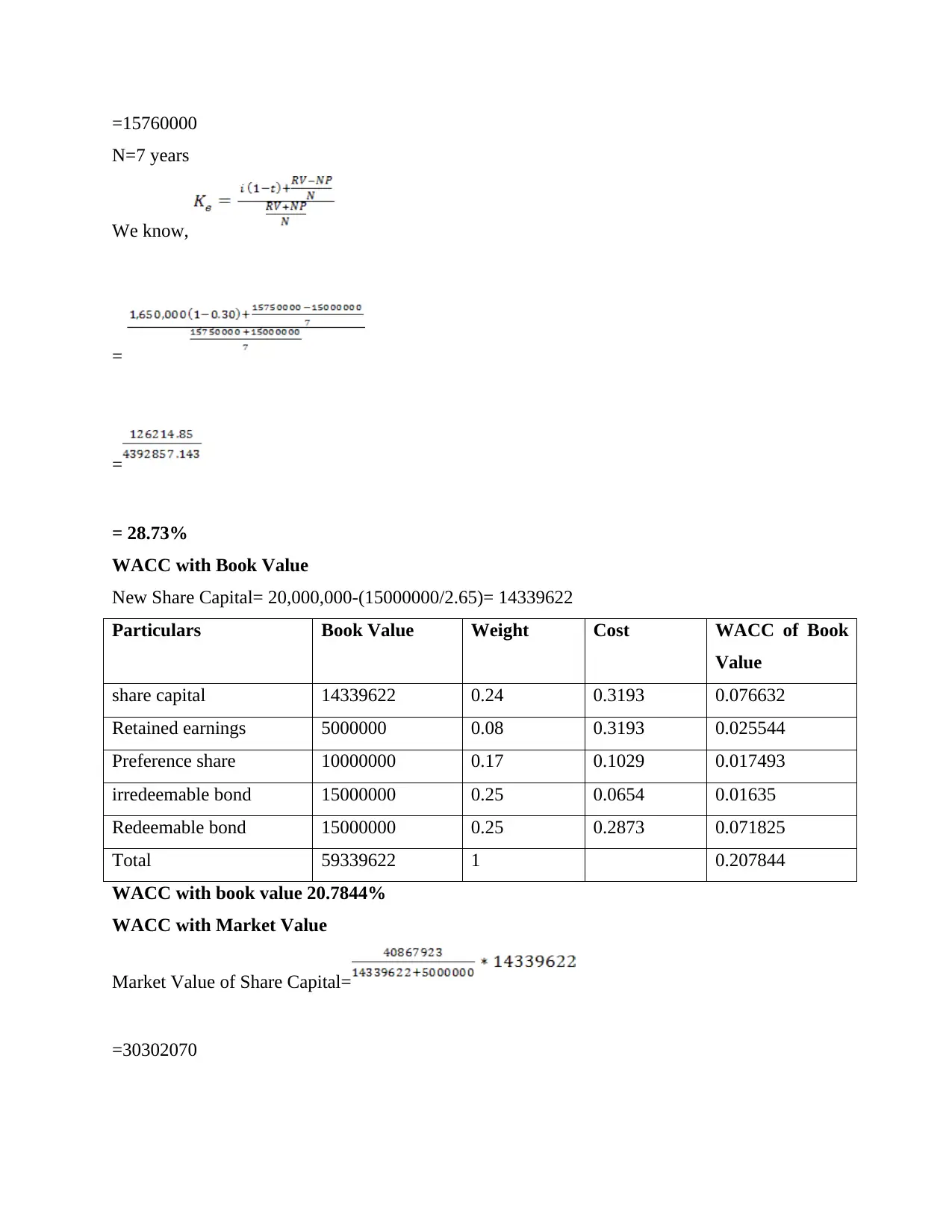
=15760000
N=7 years
We know,
=
=
= 28.73%
WACC with Book Value
New Share Capital= 20,000,000-(15000000/2.65)= 14339622
Particulars Book Value Weight Cost WACC of Book
Value
share capital 14339622 0.24 0.3193 0.076632
Retained earnings 5000000 0.08 0.3193 0.025544
Preference share 10000000 0.17 0.1029 0.017493
irredeemable bond 15000000 0.25 0.0654 0.01635
Redeemable bond 15000000 0.25 0.2873 0.071825
Total 59339622 1 0.207844
WACC with book value 20.7844%
WACC with Market Value
Market Value of Share Capital=
=30302070
N=7 years
We know,
=
=
= 28.73%
WACC with Book Value
New Share Capital= 20,000,000-(15000000/2.65)= 14339622
Particulars Book Value Weight Cost WACC of Book
Value
share capital 14339622 0.24 0.3193 0.076632
Retained earnings 5000000 0.08 0.3193 0.025544
Preference share 10000000 0.17 0.1029 0.017493
irredeemable bond 15000000 0.25 0.0654 0.01635
Redeemable bond 15000000 0.25 0.2873 0.071825
Total 59339622 1 0.207844
WACC with book value 20.7844%
WACC with Market Value
Market Value of Share Capital=
=30302070
Paraphrase This Document
Need a fresh take? Get an instant paraphrase of this document with our AI Paraphraser
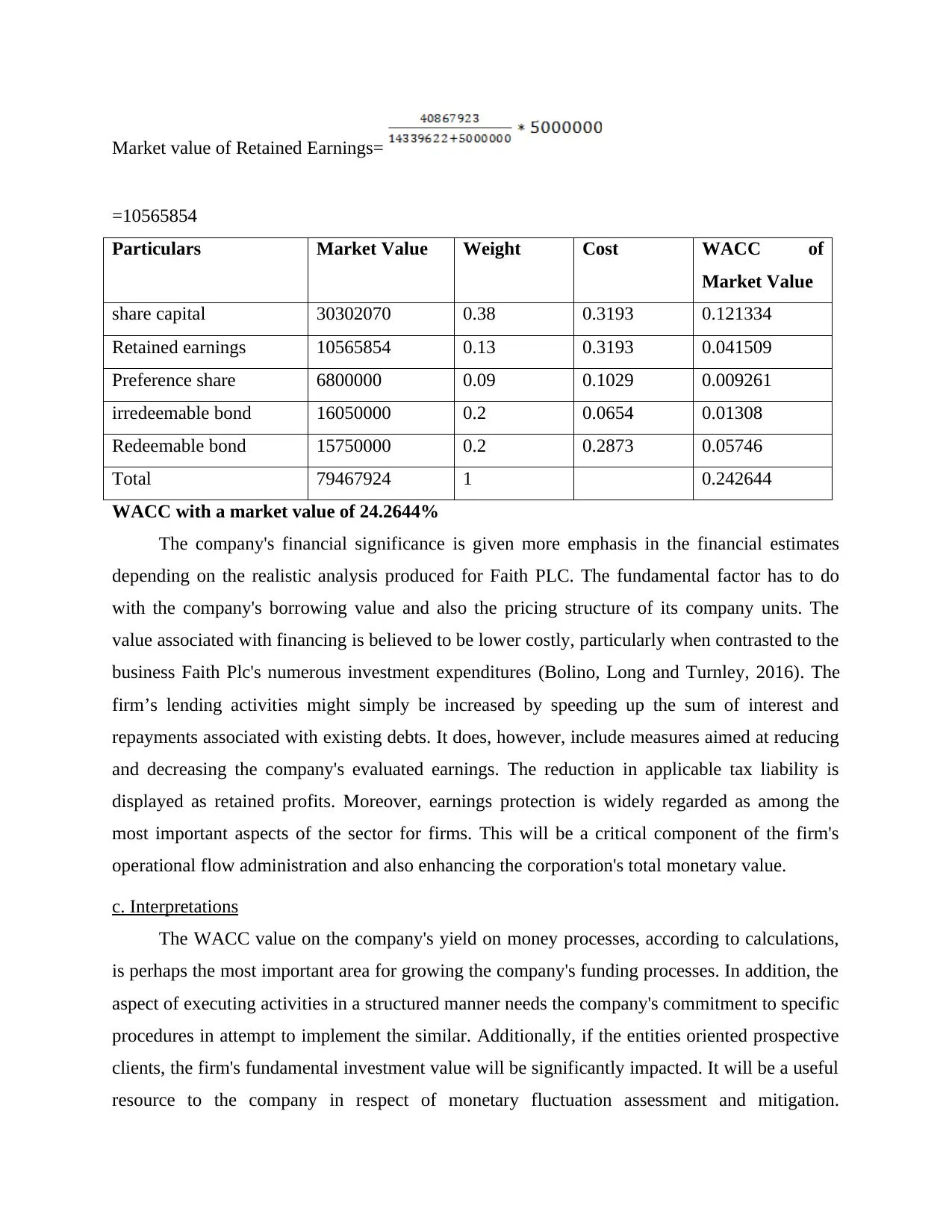
Market value of Retained Earnings=
=10565854
Particulars Market Value Weight Cost WACC of
Market Value
share capital 30302070 0.38 0.3193 0.121334
Retained earnings 10565854 0.13 0.3193 0.041509
Preference share 6800000 0.09 0.1029 0.009261
irredeemable bond 16050000 0.2 0.0654 0.01308
Redeemable bond 15750000 0.2 0.2873 0.05746
Total 79467924 1 0.242644
WACC with a market value of 24.2644%
The company's financial significance is given more emphasis in the financial estimates
depending on the realistic analysis produced for Faith PLC. The fundamental factor has to do
with the company's borrowing value and also the pricing structure of its company units. The
value associated with financing is believed to be lower costly, particularly when contrasted to the
business Faith Plc's numerous investment expenditures (Bolino, Long and Turnley, 2016). The
firm’s lending activities might simply be increased by speeding up the sum of interest and
repayments associated with existing debts. It does, however, include measures aimed at reducing
and decreasing the company's evaluated earnings. The reduction in applicable tax liability is
displayed as retained profits. Moreover, earnings protection is widely regarded as among the
most important aspects of the sector for firms. This will be a critical component of the firm's
operational flow administration and also enhancing the corporation's total monetary value.
c. Interpretations
The WACC value on the company's yield on money processes, according to calculations,
is perhaps the most important area for growing the company's funding processes. In addition, the
aspect of executing activities in a structured manner needs the company's commitment to specific
procedures in attempt to implement the similar. Additionally, if the entities oriented prospective
clients, the firm's fundamental investment value will be significantly impacted. It will be a useful
resource to the company in respect of monetary fluctuation assessment and mitigation.
=10565854
Particulars Market Value Weight Cost WACC of
Market Value
share capital 30302070 0.38 0.3193 0.121334
Retained earnings 10565854 0.13 0.3193 0.041509
Preference share 6800000 0.09 0.1029 0.009261
irredeemable bond 16050000 0.2 0.0654 0.01308
Redeemable bond 15750000 0.2 0.2873 0.05746
Total 79467924 1 0.242644
WACC with a market value of 24.2644%
The company's financial significance is given more emphasis in the financial estimates
depending on the realistic analysis produced for Faith PLC. The fundamental factor has to do
with the company's borrowing value and also the pricing structure of its company units. The
value associated with financing is believed to be lower costly, particularly when contrasted to the
business Faith Plc's numerous investment expenditures (Bolino, Long and Turnley, 2016). The
firm’s lending activities might simply be increased by speeding up the sum of interest and
repayments associated with existing debts. It does, however, include measures aimed at reducing
and decreasing the company's evaluated earnings. The reduction in applicable tax liability is
displayed as retained profits. Moreover, earnings protection is widely regarded as among the
most important aspects of the sector for firms. This will be a critical component of the firm's
operational flow administration and also enhancing the corporation's total monetary value.
c. Interpretations
The WACC value on the company's yield on money processes, according to calculations,
is perhaps the most important area for growing the company's funding processes. In addition, the
aspect of executing activities in a structured manner needs the company's commitment to specific
procedures in attempt to implement the similar. Additionally, if the entities oriented prospective
clients, the firm's fundamental investment value will be significantly impacted. It will be a useful
resource to the company in respect of monetary fluctuation assessment and mitigation.
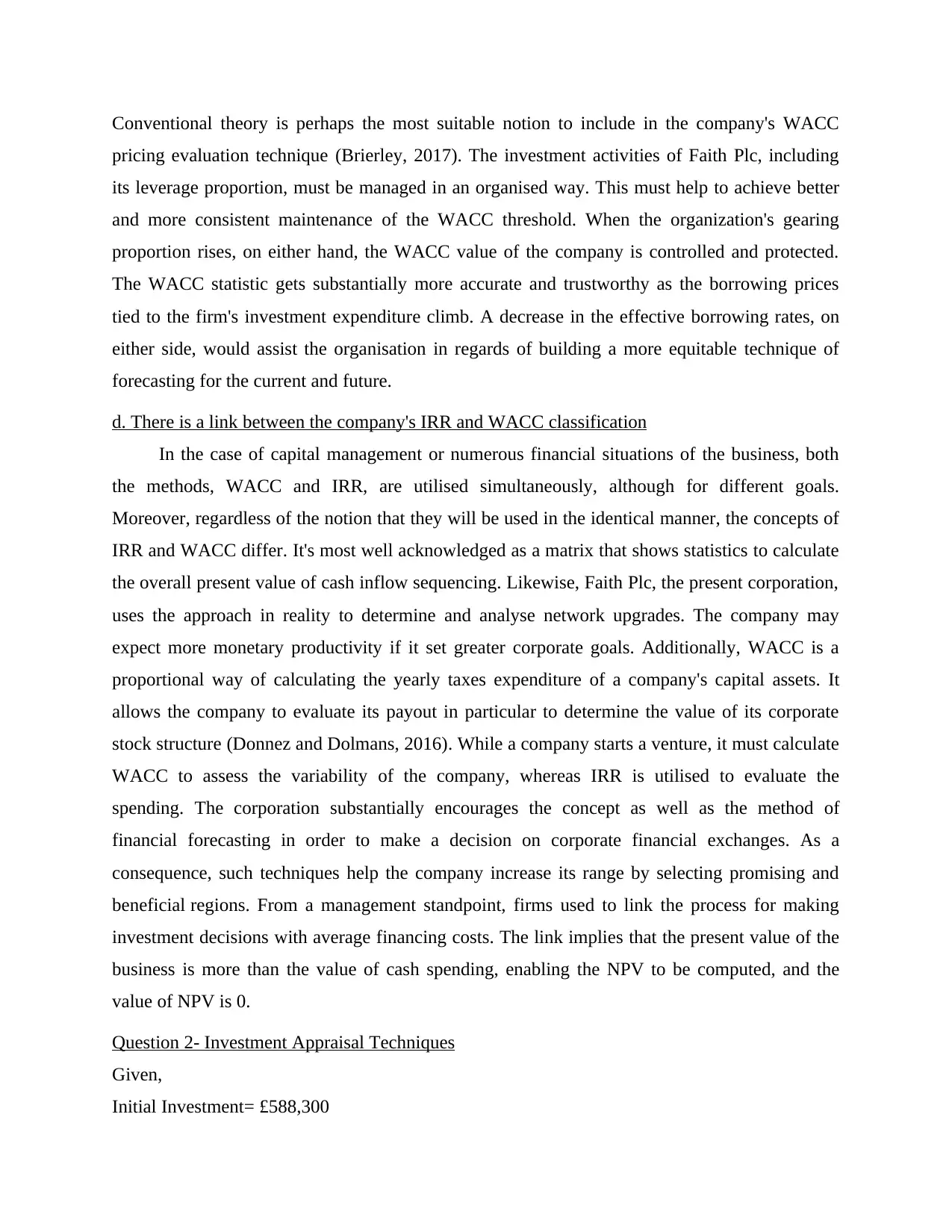
Conventional theory is perhaps the most suitable notion to include in the company's WACC
pricing evaluation technique (Brierley, 2017). The investment activities of Faith Plc, including
its leverage proportion, must be managed in an organised way. This must help to achieve better
and more consistent maintenance of the WACC threshold. When the organization's gearing
proportion rises, on either hand, the WACC value of the company is controlled and protected.
The WACC statistic gets substantially more accurate and trustworthy as the borrowing prices
tied to the firm's investment expenditure climb. A decrease in the effective borrowing rates, on
either side, would assist the organisation in regards of building a more equitable technique of
forecasting for the current and future.
d. There is a link between the company's IRR and WACC classification
In the case of capital management or numerous financial situations of the business, both
the methods, WACC and IRR, are utilised simultaneously, although for different goals.
Moreover, regardless of the notion that they will be used in the identical manner, the concepts of
IRR and WACC differ. It's most well acknowledged as a matrix that shows statistics to calculate
the overall present value of cash inflow sequencing. Likewise, Faith Plc, the present corporation,
uses the approach in reality to determine and analyse network upgrades. The company may
expect more monetary productivity if it set greater corporate goals. Additionally, WACC is a
proportional way of calculating the yearly taxes expenditure of a company's capital assets. It
allows the company to evaluate its payout in particular to determine the value of its corporate
stock structure (Donnez and Dolmans, 2016). While a company starts a venture, it must calculate
WACC to assess the variability of the company, whereas IRR is utilised to evaluate the
spending. The corporation substantially encourages the concept as well as the method of
financial forecasting in order to make a decision on corporate financial exchanges. As a
consequence, such techniques help the company increase its range by selecting promising and
beneficial regions. From a management standpoint, firms used to link the process for making
investment decisions with average financing costs. The link implies that the present value of the
business is more than the value of cash spending, enabling the NPV to be computed, and the
value of NPV is 0.
Question 2- Investment Appraisal Techniques
Given,
Initial Investment= £588,300
pricing evaluation technique (Brierley, 2017). The investment activities of Faith Plc, including
its leverage proportion, must be managed in an organised way. This must help to achieve better
and more consistent maintenance of the WACC threshold. When the organization's gearing
proportion rises, on either hand, the WACC value of the company is controlled and protected.
The WACC statistic gets substantially more accurate and trustworthy as the borrowing prices
tied to the firm's investment expenditure climb. A decrease in the effective borrowing rates, on
either side, would assist the organisation in regards of building a more equitable technique of
forecasting for the current and future.
d. There is a link between the company's IRR and WACC classification
In the case of capital management or numerous financial situations of the business, both
the methods, WACC and IRR, are utilised simultaneously, although for different goals.
Moreover, regardless of the notion that they will be used in the identical manner, the concepts of
IRR and WACC differ. It's most well acknowledged as a matrix that shows statistics to calculate
the overall present value of cash inflow sequencing. Likewise, Faith Plc, the present corporation,
uses the approach in reality to determine and analyse network upgrades. The company may
expect more monetary productivity if it set greater corporate goals. Additionally, WACC is a
proportional way of calculating the yearly taxes expenditure of a company's capital assets. It
allows the company to evaluate its payout in particular to determine the value of its corporate
stock structure (Donnez and Dolmans, 2016). While a company starts a venture, it must calculate
WACC to assess the variability of the company, whereas IRR is utilised to evaluate the
spending. The corporation substantially encourages the concept as well as the method of
financial forecasting in order to make a decision on corporate financial exchanges. As a
consequence, such techniques help the company increase its range by selecting promising and
beneficial regions. From a management standpoint, firms used to link the process for making
investment decisions with average financing costs. The link implies that the present value of the
business is more than the value of cash spending, enabling the NPV to be computed, and the
value of NPV is 0.
Question 2- Investment Appraisal Techniques
Given,
Initial Investment= £588,300
⊘ This is a preview!⊘
Do you want full access?
Subscribe today to unlock all pages.

Trusted by 1+ million students worldwide
1 out of 20
Related Documents
Your All-in-One AI-Powered Toolkit for Academic Success.
+13062052269
info@desklib.com
Available 24*7 on WhatsApp / Email
![[object Object]](/_next/static/media/star-bottom.7253800d.svg)
Unlock your academic potential
Copyright © 2020–2025 A2Z Services. All Rights Reserved. Developed and managed by ZUCOL.




